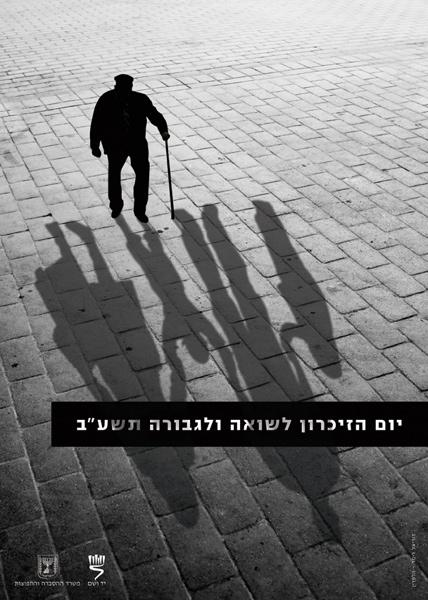[This poster is a part of an educational unit]
The poster depicts a man who is facing either towards us or away from us, and his shadow is that of a family of four – two parents and two children. The man is actually connected to the shadow of the little boy. The shadow of the family also falls over the title “Memorial Day for the Shoah and Bravery 5772”
The background of the image is a wide, paved square with the shadow of the family and the old man in the center. Aside from these images, there are no other people in the picture. The poster is in black and white only.
The main feelings that the poster raises are loss, mourning, challenge and solitude. Something seems amiss with the old man in the center of the poster, indeed the shadow adds the images of additional individuals that are no longer alive. It seems that the man is walking forward, but his past accompanies him against his will, like a shadow, wherever he goes. The black and white coloring emphasizes the sad and difficult issue that it presents.
The poster raises the point of “trauma of loss” in a number of ways:
The total emptiness and disappearance of the people who are throwing the shadow –we expect that they will actually be there, really be there, but they aren’t. This is surprising and painful but already apparent when viewing the poster for the first time.
The same heartbreaking tear also emanates from the image of the old man walking in the street, surrounded by the shadow of his family. We understand that he should be accompanied by the actual people themselves but they are missing, and his loneliness is emphasized by the shadows.
The streets of the city in which he walks also convey isolation and heighten the sense of loneliness – a person who lost his immediate family walks alone in a world full of people.
The moment that the picture is taken is not defined nor is it a factor, and as a result the statement is a general one about Holocaust survivors – their solitude is not dependent on time or place.
From the photo in the poster one is not able to determine with certainty whether the person is fleeing from the shadows, from the past forward, or if they are facing the shadows, towards the past. Is he trying to distance himself from the memories of the past and begin anew or is he constantly looking at his past without and establishing a closed reality in which there is only him and his past.
In the poster it appears that the man who is walking alone was the young boy in the family. He holds his parents’ hands on both sides and they provide him with protection and warmth and might even be treating him to a family stroll.
Family provides a person with all their material needs – protection from cold, from hunger, from disease, - and their emotional needs – love, joy, a feeling of belonging, intimate relationships. Forced and sudden separation from loved ones is bound to come at a very high price. For many it meant the loss of trust in adults and difficulties in developing close and intimate relationships in the future.
It seems that the man in the center of this poster refuses, or is unable to separate from all the elements that his family provided. He walks alone but carries the shadow of his entire family, their absence and his longing. They accompany him wherever he goes, and in that sense he himself is a child.
The poster "takes place" in the past and in the present. The images in the poster are of the family that existed in the past, of a Shoah survivor who is alive in the present. The future is not found in the poster. Even from a graphic standpoint, the landscape that the old man is walking towards is empty.
It could be that the reason for focusing on the past is due to the renewed interest in and investigations of Shoah survivors. The majority of survivors built new lives for themselves after the Shoah – raised families, studied, worked and lived. The poster ask us to see what a survivor carries with them throughout their lives as a result of the great loss they experienced due to the Shoah.







